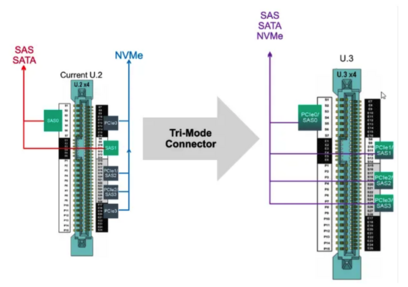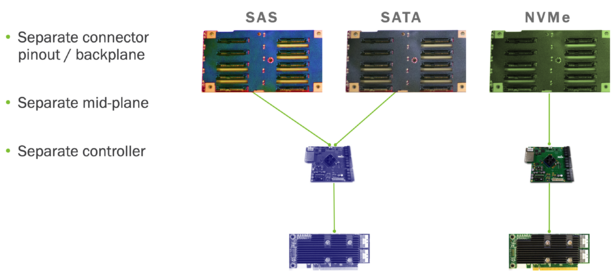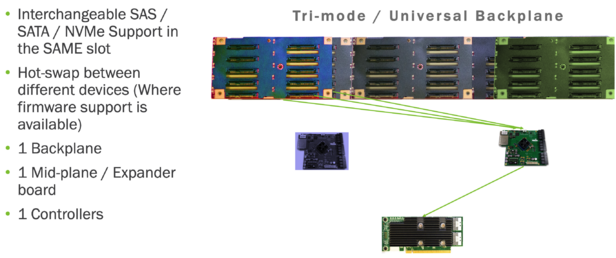Template:Tri-mode: Difference between revisions
| Line 29: | Line 29: | ||
[[File:Storage Today & Past.png|center|thumb|612x612px|Storage Today<ref>https://www.opencompute.org/files/OCP-Trimode-Presentation-Final.pdf</ref>]] | [[File:Storage Today & Past.png|center|thumb|612x612px|Storage Today<ref>https://www.opencompute.org/files/OCP-Trimode-Presentation-Final.pdf</ref>]] | ||
[[File:Tri-mode storage.png|center|thumb|616x616px|Tri-mode storage<ref>https://www.opencompute.org/files/OCP-Trimode-Presentation-Final.pdf</ref>]] | [[File:Tri-mode storage.png|center|thumb|616x616px|Tri-mode storage<ref>https://www.opencompute.org/files/OCP-Trimode-Presentation-Final.pdf</ref>]] | ||
Revision as of 13:11, 13 June 2024
Tri-Mode

According to OCP-Trimode-Presentation, SAS and NVMe forecasted to increase over the coming years and SATA to decrease.
U.3 is a ‘Tri-mode’ standard, building on the U.2 spec and using the same SFF-8639 connector. It combines SAS, SATA, and NVMe support into a single controller. So, U.3 only requires 1 backplane, 1 mid-plane, and 1 controller, supporting all these drives in the same slot.
Tri-mode controllers alone are not enough, here the disc backplanes also come into play.
For the perfect Tri-Mode operation, system needs to have
• One Backplane
• One connector
• Less high-speed lanes to backplane
• One Mid-plane
• Tri-mode Expander
• One HBA / RAID Controller
Tri-Mode controllers should be PCIe 4.0 and it means that the slot and our disks in the server should be 24G.
On a PCIe 3.0 server, you can use all disk types at the same time with tri-mode controls and U.2 and/or U.3 disk backplane, of course, it will work at PCIe 3.0 and U.2 speed in terms of performance
Storage Today vs Tri-mode

